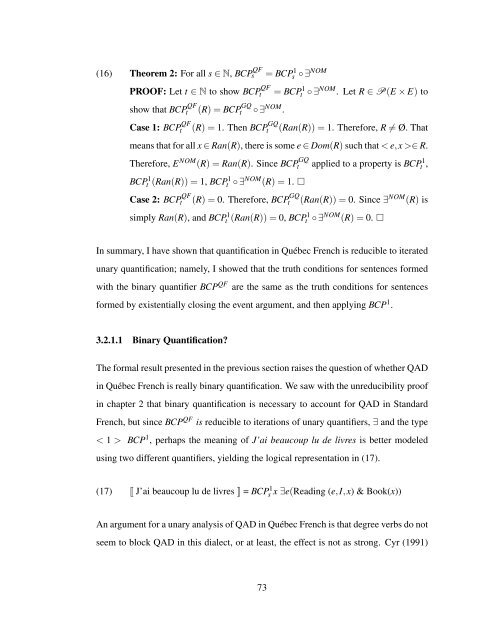Formal Approaches to Semantic Microvariation: Adverbial ...
Formal Approaches to Semantic Microvariation: Adverbial ...
Formal Approaches to Semantic Microvariation: Adverbial ...
Create successful ePaper yourself
Turn your PDF publications into a flip-book with our unique Google optimized e-Paper software.
(16) Theorem 2: For all s ∈ N, BCPs<br />
QF = BCPs 1 ◦ ∃ NOM<br />
PROOF: Let t ∈ N <strong>to</strong> show BCP QF<br />
t = BCP 1<br />
t ◦ ∃ NOM . Let R ∈ P(E × E) <strong>to</strong><br />
show that BCPt<br />
QF (R) = BCPt GQ ◦ ∃ NOM .<br />
Case 1: BCP QF<br />
t<br />
(R) = 1. Then BCPt<br />
GQ (Ran(R)) = 1. Therefore, R ≠ Ø. That<br />
means that for all x ∈ Ran(R), there is some e ∈ Dom(R) such that < e,x >∈ R.<br />
Therefore, E NOM (R) = Ran(R). Since BCP GQ<br />
t applied <strong>to</strong> a property is BCP 1<br />
t ,<br />
BCP 1<br />
t (Ran(R)) = 1, BCP 1<br />
t ◦ ∃ NOM (R) = 1. □<br />
Case 2: BCP QF<br />
t<br />
(R) = 0. Therefore, BCPt<br />
GQ (Ran(R)) = 0. Since ∃ NOM (R) is<br />
simply Ran(R), and BCP 1<br />
t (Ran(R)) = 0, BCP 1<br />
t ◦ ∃ NOM (R) = 0. □<br />
In summary, I have shown that quantification in Québec French is reducible <strong>to</strong> iterated<br />
unary quantification; namely, I showed that the truth conditions for sentences formed<br />
with the binary quantifier BCP QF are the same as the truth conditions for sentences<br />
formed by existentially closing the event argument, and then applying BCP 1 .<br />
3.2.1.1 Binary Quantification?<br />
The formal result presented in the previous section raises the question of whether QAD<br />
in Québec French is really binary quantification. We saw with the unreducibility proof<br />
in chapter 2 that binary quantification is necessary <strong>to</strong> account for QAD in Standard<br />
French, but since BCP QF is reducible <strong>to</strong> iterations of unary quantifiers, ∃ and the type<br />
< 1 > BCP 1 , perhaps the meaning of J’ai beaucoup lu de livres is better modeled<br />
using two different quantifiers, yielding the logical representation in (17).<br />
(17) J’ai beaucoup lu de livres = BCP 1 s x ∃e(Reading (e,I,x) & Book(x))<br />
An argument for a unary analysis of QAD in Québec French is that degree verbs do not<br />
seem <strong>to</strong> block QAD in this dialect, or at least, the effect is not as strong. Cyr (1991)<br />
73
















